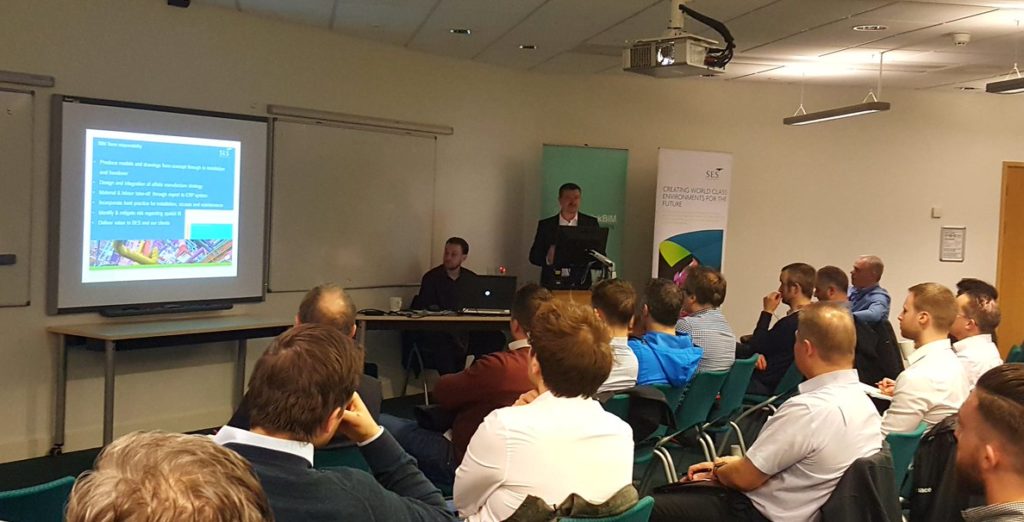BIM Beyond Design: Design for Manufacture and Assembly

Over 40 construction professionals gathered in the Rose Bowl in Leeds yesterday evening for what was a great start to think BIM’s summer event series. A detailed view of BIM implementation and practice delivered by our speakers offering perspectives from a structural steel decking subcontractor, M& E specialist and an international product manufacturer.
Adrian Shepherd of Richard Lees took the group through the processes used for the manufacture, scheduling and installation of ‘crinkly tin’ steel decking and the benefits and efficiencies brought about through the use of Tekla. Martin Howe and Az Jasat from SES (part of the Shepherd Group) gave an excellent open and frank view of BIM from the perspective of M&E modularisation, offsite manufacture and project implementation using a variety of BIM tools. Kingspan’s Bill Gibson presented a component manufacturers’ view of the BIM race and how the imperative to stay ahead of the competition and contribute to the upstream supply chain’s demands for digital information was being met.
Adrian highlighted the need to understand the each part of the construction process when considering a BIM strategy particularly where Tier 2 and 3 supply chain is concerned. Their ability to use the software to deal with complex geometry ensures that waste can be minimised when much of the site processes are done off site, which also contributes to the reduction of working at height risk and noisy acitivities on site. Adrian cited the value of early engagement, and the need for up to date, digital data to ensure that all aspects of the build such as Health and Safety fixings during installation, service penetrations and construction detailing are ‘built in’ to the solution.
Martin and Az shared very openly and candidly their experience of implementing BIM within their business. This gave the audience an insight into both the SES BIM team and the SES Prism offsite manufacturing’s activities and how these are used to deliver added value to their clients. Martin started by reassuring the audience that they are really quite advanced in their lonely world of BIM. ‘Key to enabling BIM is how we get individual pockets of BIM excellence to work together as a whole’, says Martin. SES have BIM embedded within their strategic plan and whilst they are making much progress traditional procurement processes and procedures were cited as barriers to fully realising the true potential of BIM and the increased value this can bring to the client. Again the importance of early engagement is critical to realise the benefits both in installation and the quality of the finished product, echoing Adrians view. Az shared the view that BIM is still poorly understood and defined; although this for them provides an opportunity to lead the way with their clients, helping them see through the hype. Martin hinted at the importance of seeking out fellow believers via groups like thinkBIM. It was clear form their informative and inspiring presentation that BIM was nothing new to SES and was high on their agenda being a business imperative. Clearly and significantly BIM is being seen not just as an drawing tool but as something that will affect the entire way in which SES does business, from tender/estimate, through procurement to handover and operation. It was stressed that the software is relatively easy and quick for employees to grasp but deep understanding of engineering technology is essential to deliver the optimal solution, BIM does not displace sound engineering knowledge and practice but is a tool to improve efficiency of design and site processes.
Bill gave the final presentation offering the manufacturer’s perspective on BIM. Firstly Bill noted their realisation for the need to be able to provide the same level of product information as they currently do but in a digital format. In order for Kingspan to understand what is required of them they have been actively involved in better understanding where the specifiers, contractors and consultants are along the BIM journey in order to adapt and align to the emerging BIM processes. A key concern remains in respect of which standards to adopt and the continuing struggle with regard to format, IFC’s and COBie etc.
A lively Q and A focussed mainly around traditional procurement as a barrier to BIM value for clients and how early engagement of manufacturers and consultants would bring huge benefits to contracts, given the ability to demonstrate and evidence the value proposition for BIM, something we will be investigating later in our series.

